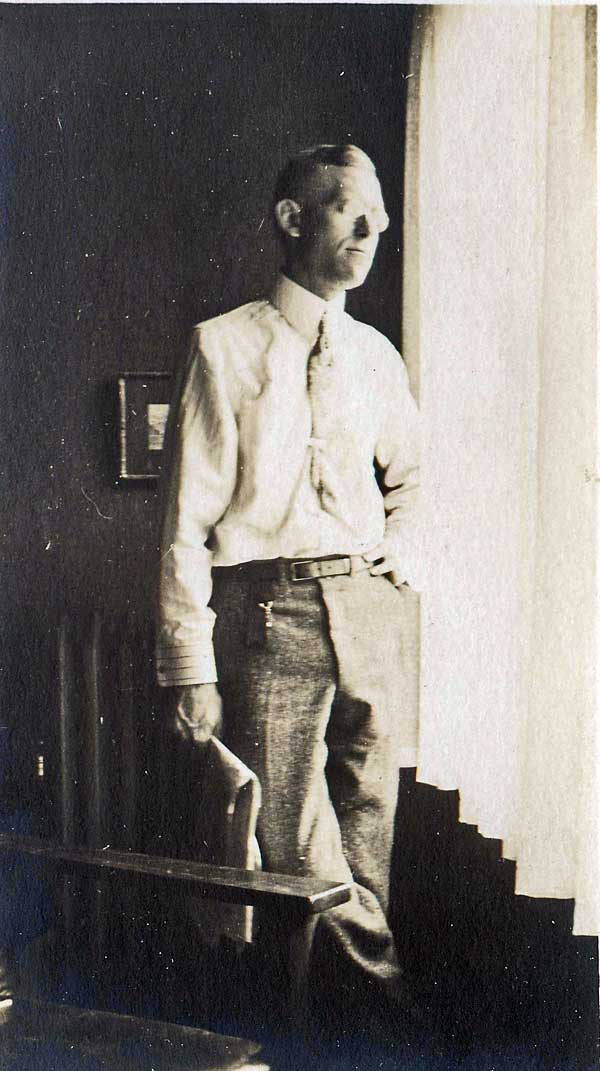 |
| Walter A. Richelsen, Last Superintendent at Kennecott --Richelsen |
W.A. Richelsen sat in the large oak office chair which a few years before had been
occupied by the legendary Bill Douglass. Walter had finally taken over the prestigious
superintendent’s position two years ago, although he had been in various
engineering positions on the site for over twenty years. Since Douglass left in
1929, other superintendents had come and gone. In the end the job finally fell
to Richelsen. Now Kennecott’s long run at this interior Alaska mine was finally
coming to an end.
superintendent’s position two years ago, although he had been in various
engineering positions on the site for over twenty years. Since Douglass left in
1929, other superintendents had come and gone. In the end the job finally fell
to Richelsen. Now Kennecott’s long run at this interior Alaska mine was finally
coming to an end.
The mill stood silent and unlit. It was a mammoth presence among a group of dying dinosaurs. It seemed so odd to be next to the mill without hearing the constant
crushing, grinding and sifting sounds. Even the power plant was quiet. Only one
of the four boilers remained on line. It created a nearly imperceptible roar as the
flames continued to burn for just a short while longer. The generators had been
shipped out. All power was coming from Bonanza Creek water feeding the Pelton
wheel. Soon that would freeze up and the remaining power would be gone. Then
the few briefly remaining residents would have to live in the small, wood-heated
cottages, and use kerosene lamps.
flames continued to burn for just a short while longer. The generators had been
shipped out. All power was coming from Bonanza Creek water feeding the Pelton
wheel. Soon that would freeze up and the remaining power would be gone. Then
the few briefly remaining residents would have to live in the small, wood-heated
cottages, and use kerosene lamps.
The last load of ore for Mother Lode had come down the tram during the first week of August, just days after the July 31 closure of the property. Since Mother Lode had been
the prime producer since the early 1920’s, the ML closure, well in advance of
the three remaining mines, was a sobering reminder that the end really was
near. The end of the Mother Lode meant that the painful memories associated
with the greatest disaster ever to hit the Alaskan operation would finally be
buried and forgotten.
the prime producer since the early 1920’s, the ML closure, well in advance of
the three remaining mines, was a sobering reminder that the end really was
near. The end of the Mother Lode meant that the painful memories associated
with the greatest disaster ever to hit the Alaskan operation would finally be
buried and forgotten.
On the opposite end of the 3,000 acres of mining claims, the remote part of the property known as the Erie closed on October 15th. An unexpected last-minute ore discovery
extended its life, keeping the ore trains running full several months longer than anticipated.
extended its life, keeping the ore trains running full several months longer than anticipated.
When the Erie shut-down finally came, the others quickly followed. Jumbo closed only
a day later on the 18th, and the Bonanza closed on October 22nd, leaving Bonanza with
the distinction of being the first mine to open and the last one to close. In
the last two years, extensive cleanups included a final combing of the slide ore
around Bonanza and of the ores which had fallen off the two long ore-trams,
especially around the junction and angle stations.
the distinction of being the first mine to open and the last one to close. In
the last two years, extensive cleanups included a final combing of the slide ore
around Bonanza and of the ores which had fallen off the two long ore-trams,
especially around the junction and angle stations.
 |
| The Kennecott General Office in serene repose in the ghost town of Kennecott in the 1960s. By the time this photo was taken, the last superintendent had already passed away. |
Now it was finally over. All those lights which had shined thousands of feet above the mill
for twenty-seven years were now permanently shut off. The power line to Bonanza
remained intact, but the line to Erie was in the process of being dismantled.
Richelsen could still run power throughout the mines if he chose, though the
capacity at the power plant had been greatly diminished. No one was up on the
ridge or anywhere along the tram lines. It was dead quiet up there.
for twenty-seven years were now permanently shut off. The power line to Bonanza
remained intact, but the line to Erie was in the process of being dismantled.
Richelsen could still run power throughout the mines if he chose, though the
capacity at the power plant had been greatly diminished. No one was up on the
ridge or anywhere along the tram lines. It was dead quiet up there.
The last of the ore was processed through the mill and loaded on the final ore train on October 31. The hulking shadow of the bright, freshly painted red mill, now loomed in
perpetual silence above the small office as a reminder of a technology that once
was state-of-the-art, but which had now become obsolete as the mill gradually
wore out after a dozen years of deferred maintenance.
perpetual silence above the small office as a reminder of a technology that once
was state-of-the-art, but which had now become obsolete as the mill gradually
wore out after a dozen years of deferred maintenance.
The remaining activity centered on salvage of the various industrial buildings along
the track grade. The power plant had already been stripped of its generators, turbines
and other critical parts. Only the Pelton wheel and the four Erie-brand boilers would
and other critical parts. Only the Pelton wheel and the four Erie-brand boilers would
be left behind.
The machine shop was cleaned out of all its belt-driven tools in a matter of days after
the last mine closed. A few critical components in the water flotation plant were
now being removed. The ammonia leaching plant would to be left intact, but
Richelsen intended to drain the remaining ammonia out of the eight 50,000 gallon
tanks and other smaller ones. Thousands of gallons of ammonia would end up
running under the Kennicott Glacier, bound for the Copper River.
now being removed. The ammonia leaching plant would to be left intact, but
Richelsen intended to drain the remaining ammonia out of the eight 50,000 gallon
tanks and other smaller ones. Thousands of gallons of ammonia would end up
running under the Kennicott Glacier, bound for the Copper River.
The last train to arrive for the year, was now somewhere past Shushanna Junction,
working its way up the hill toward Kennecott. Senior engineer Sal Reed had the honor of
being at the controls of engine No. 74--The Last Train Out.
being at the controls of engine No. 74--The Last Train Out.
Every last miner who had lived in the upper camps had left on earlier trains. All of the
salvageable mining equipment, from the large air compressors to the stope bits
on the drill rigs, to the battery-powered locomotives had been shipped out on
those same trains.
salvageable mining equipment, from the large air compressors to the stope bits
on the drill rigs, to the battery-powered locomotives had been shipped out on
those same trains.
Up above at the 6000 foot level, the tallest building sitting at the highest point on the
property was the main Bonanza barracks. This afternoon it sat silently in a
state of permanent darkness that would last for twenty years. No longer would
there be anyone sitting in the vast Bonanza dining hall, appreciating the
panoramic view of the distant Chugach Range and the nearby Porphyry Mountain
with its scenic rock glacier. The tables, chairs and most all of the other camp
furnishings remained in place, leaving the building in a state of suspension, as
if it was awaiting a new crew. Even the kitchen and pantry remained fully
stocked with non-perishables, including several large bags of various types of
dried beans.
property was the main Bonanza barracks. This afternoon it sat silently in a
state of permanent darkness that would last for twenty years. No longer would
there be anyone sitting in the vast Bonanza dining hall, appreciating the
panoramic view of the distant Chugach Range and the nearby Porphyry Mountain
with its scenic rock glacier. The tables, chairs and most all of the other camp
furnishings remained in place, leaving the building in a state of suspension, as
if it was awaiting a new crew. Even the kitchen and pantry remained fully
stocked with non-perishables, including several large bags of various types of
dried beans.
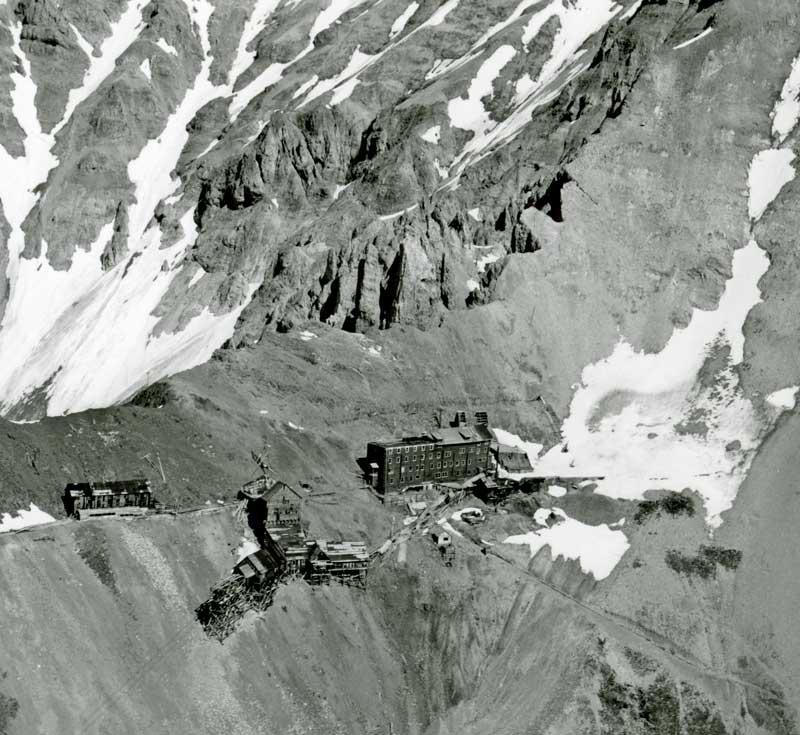 |
| The abandoned Bonanza mine site in 1955. --Ward Wells, AMHA |
Upstairs the beds waited for miners who would never again walk down those hallways.
As if the barrack was still occupied, some of the windows had been left open. Downstairs
in one of the large rooms in the back, two billiards tables sat in a very dark
room, waiting for players who would never walk through the blocked-open doors.
In an adjacent room, a film projector sat waiting for another reel that would
never be loaded. Down below in the darkness of the basement drying room,
several rows of locker doors had been left wide open--many of them still
holding miner’s helmets and outer wear. Water no longer dripped from the
shower heads, because the supply of water had long since dried up.
in one of the large rooms in the back, two billiards tables sat in a very dark
room, waiting for players who would never walk through the blocked-open doors.
In an adjacent room, a film projector sat waiting for another reel that would
never be loaded. Down below in the darkness of the basement drying room,
several rows of locker doors had been left wide open--many of them still
holding miner’s helmets and outer wear. Water no longer dripped from the
shower heads, because the supply of water had long since dried up.
Just below the huge barracks and mess hall the long snowshed leading to the upper
tram terminal was completely dark. The thirty-inch rails running along the inclined
ramp had been used for twenty years to transport the water and coal up to the barracks.
Now the inclined shed stood empty. At the base of the snowshed on the tram
landing a third pool table sat on its side, packed and awaiting a shipment down
the tram which would never happen. Richelsen had decided to leave the table
behind. Wind from the tram opening on the very far end of this shed blew up the
long narrow inclined snowshed toward the main barrack, providing an eerie
whistling sound which no one could hear.
Now the inclined shed stood empty. At the base of the snowshed on the tram
landing a third pool table sat on its side, packed and awaiting a shipment down
the tram which would never happen. Richelsen had decided to leave the table
behind. Wind from the tram opening on the very far end of this shed blew up the
long narrow inclined snowshed toward the main barrack, providing an eerie
whistling sound which no one could hear.
The snow-shed entries to tunnels 1501, 1503, and 1505 led to heavy doors near the
surface which had been closed tight. In the absolute blackness beyond these heavy doors
the mine was dripping and forming ice which would gradually fill in several of
the tunnels forever. Similar doors had been shut at the adits at the Jumbo and
the Erie. Two hidden adits opening on McCarthy Creek from high above in the
Mother Lode workings also had heavy, closed doors holding in the cold air which
still blew throughout the many miles of open tunnels. The main adit at Mother
Lode, however, was buried under tons of debris, leaving no trace of the original
eighty-foot long snowshed which marked the entry to the Rhodes tunnel.
the mine was dripping and forming ice which would gradually fill in several of
the tunnels forever. Similar doors had been shut at the adits at the Jumbo and
the Erie. Two hidden adits opening on McCarthy Creek from high above in the
Mother Lode workings also had heavy, closed doors holding in the cold air which
still blew throughout the many miles of open tunnels. The main adit at Mother
Lode, however, was buried under tons of debris, leaving no trace of the original
eighty-foot long snowshed which marked the entry to the Rhodes tunnel.
Just beyond the talus slide, a large concrete slab and a diminishing pile of heavy timbers and other rubble marked the unrecognizable remains of the seventy-five man Mother
Lode camp. Years of ongoing erosion combined with annual snow slides had wiped
out what little remained of the disaster of 1927. The wind whistled through the
gulch nearly constantly, but it went unheard. Talus continued to break loose
from the rocky faces which bounded old Potter Gulch. Annual winter snows
accumulated in the upper reaches of the gulch only to break loose every spring,
roaring down the slide zone in a deadly mass of icy rage, except, no longer was
there anyone in harm’s way.
Lode camp. Years of ongoing erosion combined with annual snow slides had wiped
out what little remained of the disaster of 1927. The wind whistled through the
gulch nearly constantly, but it went unheard. Talus continued to break loose
from the rocky faces which bounded old Potter Gulch. Annual winter snows
accumulated in the upper reaches of the gulch only to break loose every spring,
roaring down the slide zone in a deadly mass of icy rage, except, no longer was
there anyone in harm’s way.
Over at the Jumbo camp, an odd row of barracks stood empty and already noticeably
tilting in varying degrees toward the rock glacier below. The largest one on the east end
had been nearly destroyed by the elements years before Jumbo closed. The large
building had numerous panes of glass broken from the stress of the structure
being pulled in several different directions. All seven of the remaining major
Jumbo camp buildings had the appearance of being slowly buried in huge piles of
loose rock, broken away from the erosion of jagged cliff walls hundreds of feet
straight above the narrow, uneven bench on which the camp was built.
had been nearly destroyed by the elements years before Jumbo closed. The large
building had numerous panes of glass broken from the stress of the structure
being pulled in several different directions. All seven of the remaining major
Jumbo camp buildings had the appearance of being slowly buried in huge piles of
loose rock, broken away from the erosion of jagged cliff walls hundreds of feet
straight above the narrow, uneven bench on which the camp was built.
| Bill Douglass with a film-maker at Jumbo camp --W.C. Douglass |
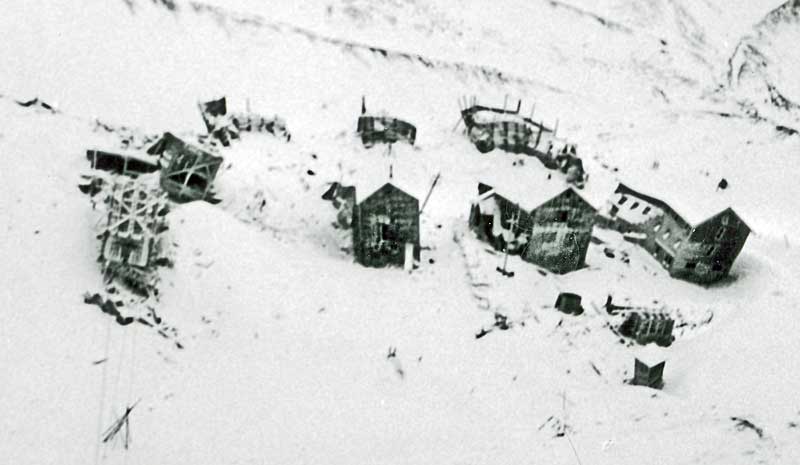 |
| Remains of the Jumbo Camp in 1970 --Stu Rothman |
Over at isolated Erie camp, the forty-man barracks stood completely intact, but had an
unfinished appearance, much like most of the buildings at Jumbo. Inside the
room which had once seen many lively exchanges between many of the white miners
and the two daring Indians, a ghostly game of billiards had already started.
Pool balls clanked against each other, moving from one end of the large table to
the other. Four unseen c’eyuuni had begun playing a game that would go
on into eternity. No one was there to watch. No one would come.
unfinished appearance, much like most of the buildings at Jumbo. Inside the
room which had once seen many lively exchanges between many of the white miners
and the two daring Indians, a ghostly game of billiards had already started.
Pool balls clanked against each other, moving from one end of the large table to
the other. Four unseen c’eyuuni had begun playing a game that would go
on into eternity. No one was there to watch. No one would come.
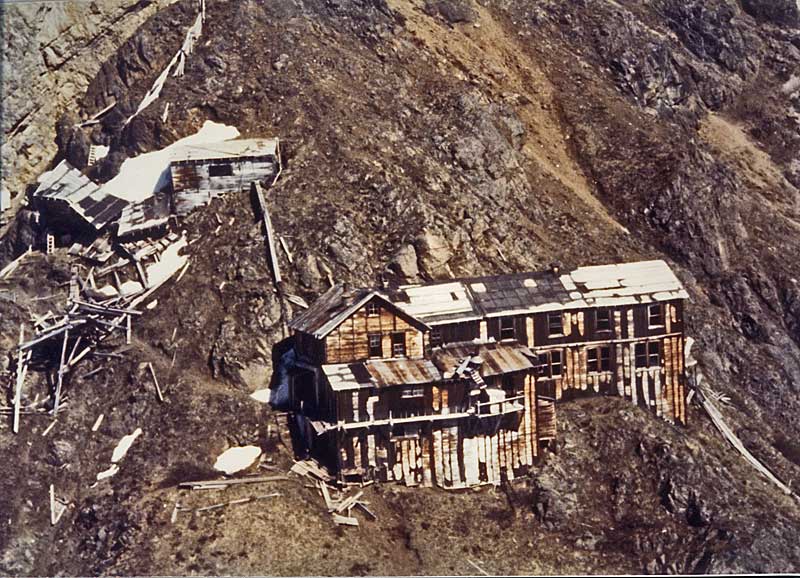 |
| Erie in 1979 --UAF AK & Polar Regions Archives |
The trams were closed and the place had become nearly inaccessible.
Walter Richelsen stood up and walked around his large oak desk to the front door. He
could finally hear the whistle--another of many small reminders that the end had
arrived. He wanted to observe the last train enter the mill site. In the last
few years the locomotive engineers had taken to running the engines forward, or
facing north, then returning to McCarthy and backing the engine up the tracks to
meet the train in the proper position--facing downhill and south. This had
always been the normal procedure in the winter to avoid backing through the
snow and to make proper use of the snowplows mounted on the front of the
locomotives, but the practice had otherwise been avoided to save the extra ten
miles of travel which this maneuver required. Lately, all the engines had
arrived facing north.
Walter could now make out the number on the boiler plate which identified the engine as No. 74 . It was pulling two passenger cars and a line of box cars for picking up one
final group of salvaged items. These would be loaded up over the course of the
evening and into the next day. The train would depart forever in the early
afternoon.
Richelsen turned to look up toward Porphyry Mountain. The gathering clouds suggested that
a winter storm was on the way.
A fitting end, especially if the coming storm turns into a blizzard. The company held off closing the railroad until the very last possible moment. It appears that this might very well be it. What superb timing.The Last Train Out, returning on one very last run from a dying copper mine through a storm which will forever close the tracks in its wake.
He looked toward the rear of the tram terminal. The trams lines looked ready to go, but
the buckets had already been removed. The tram passed the National Creek dam
reservoir. On the dam end stood the vacant Birch house. The last visitors to
use the guest house had come to investigate the mine site for possible inclusion
in a new Kennecott National Park.
the buckets had already been removed. The tram passed the National Creek dam
reservoir. On the dam end stood the vacant Birch house. The last visitors to
use the guest house had come to investigate the mine site for possible inclusion
in a new Kennecott National Park.
This would be a great area to preserve--buildings and all.
We’ll never be back, anyway. The ore is mined out. But the beauty of this country is unique and far-reaching. The mountains and the glaciers dwarf everything. What if Governor Gruening was able to convince the feds to buy all our mining property as the center of a new national park? Kennecott would have to consider it. After all, everything here is for sale now. Maybe. Who knows?
He looked up in time to see four large ravens flying high overhead. There was
something about them which seemed familiar, but Walter could not put his finger on it.
He stared, momentarily transfixed, at the high circling birds, then shrugged and
turned his attention to the empty coaches which were now lined up by the
station, awaiting tomorrow’s passengers.
turned his attention to the empty coaches which were now lined up by the
station, awaiting tomorrow’s passengers.
One last load of passengers and its really over. The rest of us will have to fly out of here. Our old wooden railroad coaches are too obsolete for us to sell in the States. Wonder what will ever become of them.
The snow squall moved in as a cold wind blasted through. In a matter of moments, light, powdery snow was blowing around the nearly abandoned town, obscuring the view
everywhere.
everywhere.
The large east barracks had been used for the last time when the last of the miners came down the trams. The miners stayed there until the train came to pick them all up.
Now it too sat in darkness. The squall began to turn into a blizzard, just as
Walter expected. The darkened Birch house and east barracks disappeared from
sight due to the blizzard conditions which had appeared out of nowhere.
Now it too sat in darkness. The squall began to turn into a blizzard, just as
Walter expected. The darkened Birch house and east barracks disappeared from
sight due to the blizzard conditions which had appeared out of nowhere.
Just across the creek from the barrack was the hospital. It remained alive, but only
because the doctor and his nurses had remained behind to pack up the medical supplies.
The drugs were to be destroyed, but everything else was to be stored in packed
boxes so the hospital could be re-used. The doctor was considered essential
personnel, and would be among the last to leave. The final crew of forty men
would remain until late December, then depart on a plane chartered out of
Cordova. Richelsen intended to be the last man to step on board.
The drugs were to be destroyed, but everything else was to be stored in packed
boxes so the hospital could be re-used. The doctor was considered essential
personnel, and would be among the last to leave. The final crew of forty men
would remain until late December, then depart on a plane chartered out of
Cordova. Richelsen intended to be the last man to step on board.
Richelsen stepped back inside the warm office. Through the swirling snow flurries Walter
thought he spotted a familiar-looking shadow next to a smaller one stranding in
front of the west barrack. Then the blowing snow obscured everything.
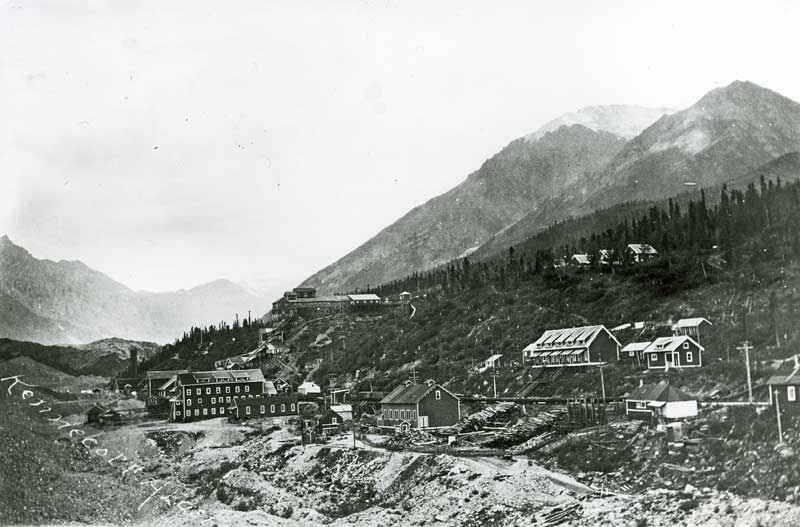 |
| South Kennecott, showing many of the cottages, including the "tent cottage" (front), the Recreation Hall, the school, and the West Bunkhouse with the mill overlooking all. --McCarthy-Kennicott Museum |
Couldn’t be. I heard he was gone. Probably dead.
The radiators inside the office were pleasantly humming with steam flowing from the one boiler which was still operating. The lights in his office were shining brightly, just
as they had in the Bonanza barracks the day W.A. presided over its closure.
as they had in the Bonanza barracks the day W.A. presided over its closure.
In the empty three-story staff house just above Walter’s office, the radiators had been shut
off. The water had been drained out of the lines and the power had been
switched off. The outer door with the lead-glass window was closed to protect
the contents. Like the many other doors in the complex, it remained unlocked.
The unused keys for the many locks to the several dozen buildings on the complex
hung in a special place in Bittner’s office. Bittner himself was long-gone, as
were the others who had followed him.
off. The water had been drained out of the lines and the power had been
switched off. The outer door with the lead-glass window was closed to protect
the contents. Like the many other doors in the complex, it remained unlocked.
The unused keys for the many locks to the several dozen buildings on the complex
hung in a special place in Bittner’s office. Bittner himself was long-gone, as
were the others who had followed him.
The staff house was cold, like an increasing number of other buildings around Kennecott. Tonight the unheated ones would become unbearably cold. On the second and third floors
of the staff house, the doors leading into the six bedrooms and the two
bathrooms on each level were left wide open to allow maximum light into the two
otherwise dark and gloomy hallways. All the furniture remained in place just as
it had for the all those years of operation, but the linens and blankets had
been packed off, as they had been from all the barracks. On the main level, the
two sitting rooms remained as they had for the last twenty-seven years since the
place was built. The main floor stood ready for engineers, nurses, and teachers
to enter, sit down, play a game of cards and perhaps listen to the player piano
in the back room as they socialized, creating years of memories that would be
stored forever within the staff house rooms.
of the staff house, the doors leading into the six bedrooms and the two
bathrooms on each level were left wide open to allow maximum light into the two
otherwise dark and gloomy hallways. All the furniture remained in place just as
it had for the all those years of operation, but the linens and blankets had
been packed off, as they had been from all the barracks. On the main level, the
two sitting rooms remained as they had for the last twenty-seven years since the
place was built. The main floor stood ready for engineers, nurses, and teachers
to enter, sit down, play a game of cards and perhaps listen to the player piano
in the back room as they socialized, creating years of memories that would be
stored forever within the staff house rooms.
Tonight no one would enter the staff house. The few remaining occupants had moved to the old, but comfortable north cottages, where it was possible to heat the small
rooms with wood and coal-burning stoves, independent of the steam heat which was
not expected to run much longer.
rooms with wood and coal-burning stoves, independent of the steam heat which was
not expected to run much longer.
For another twenty years the staff house would stand empty, waiting with everything still in
place, just as it always had been, for the engineers and the others who would
never return to breathe life into a building that had long since developed its
own spirit, independent of those who had lived there.
place, just as it always had been, for the engineers and the others who would
never return to breathe life into a building that had long since developed its
own spirit, independent of those who had lived there.
On the second floor in a room facing the superintendent’s house, the door to Frank Buckner’s
old room slammed shut. The curtains moved slightly as the storm intensified. A
tall, solitary figure stared out through the rattling glass panes in the
direction of the darkened Birch house. Then, with nothing of interest to see,
it slowly faded away into the darkness of the cold room.
old room slammed shut. The curtains moved slightly as the storm intensified. A
tall, solitary figure stared out through the rattling glass panes in the
direction of the darkened Birch house. Then, with nothing of interest to see,
it slowly faded away into the darkness of the cold room.
A frigid arctic air mass quietly moved in to push aside the storm and drop a cold blanket of air over the Wrangells. The temperatures took a rapid plunge that would reach
minus thirty-eight by the early morning hours. The blizzard began to
dissipate, vanishing as quickly as it had appeared. The mountain tops
surrounding the glacial valley once again stood out in all their stark and
intensely lonely beauty. The four large ravens landed on the peak of the
staff house, high above track grade, facing the train which had been parked for
the night. They watched, completely absorbed, while two they recognized as
their own--a middle-aged Indian and his young Native son--left the west barrack
area and slowly worked their way up the wooden walkway in the direction of
Walter Richelsen’s office.
minus thirty-eight by the early morning hours. The blizzard began to
dissipate, vanishing as quickly as it had appeared. The mountain tops
surrounding the glacial valley once again stood out in all their stark and
intensely lonely beauty. The four large ravens landed on the peak of the
staff house, high above track grade, facing the train which had been parked for
the night. They watched, completely absorbed, while two they recognized as
their own--a middle-aged Indian and his young Native son--left the west barrack
area and slowly worked their way up the wooden walkway in the direction of
Walter Richelsen’s office.
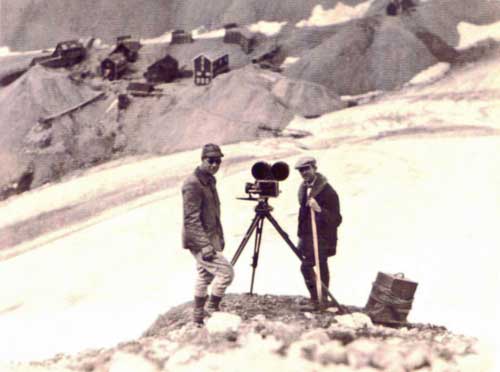
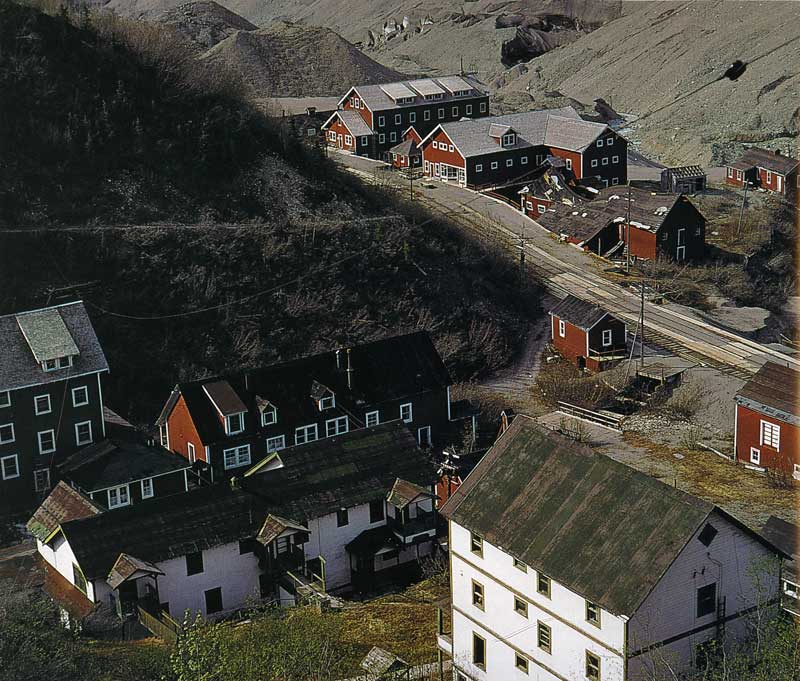
No comments:
Post a Comment